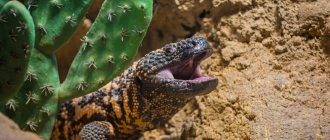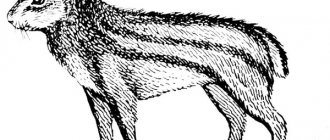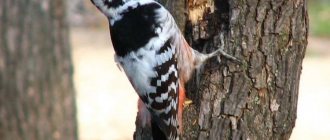The hedgehog is a permanent inhabitant of the forest, but sometimes these animals are also found in park areas. Despite the sharp needles, these animals are very cute and also bring benefits - they destroy harmful insects (unfortunately, they eat beneficial ones along with them).
I would like to note that if a hedgehog starts up in your summer cottage, this is a good sign, but you don’t need to drive it away and distract it from your important matters.
Many, probably, when they see this wonderful animal, remember the cartoon by artist and animator Yuri Norshtein “Hedgehog in the Fog” of 1975, where the characters are friends - a hedgehog and a bear. This cartoon makes your soul a little warmer, even if it’s raining outside, and “cats are scratching” in your soul. If you haven’t watched this cartoon yet, we recommend that you watch it and also take some time and read about hedgehogs – these charming little animals.
We bring to your attention 10 interesting facts about hedgehogs - prickly but cute babies.
Some of the most ancient mammals
Hedgehogs are widespread in Europe. We have known about this animal since childhood, having become acquainted with it from various fairy tales and cartoons. Hedgehogs are the most ancient mammals (along with shrews) from the order of insectivores .
For 15 million years now, these animals have inhabited different cities and countries. The only thing is that they avoid those climatic zones in which there is constant cold, as well as swampy areas.
Interesting fact: scientists have found an ancient “hedgehog” that lived during the time of dinosaurs (125 million years ago), but it looked different. This creature had large ears, short hair, an elongated muzzle and a fluffy belly. It lived in burrows and ate insects.
These animals from the order of insectivores have been inhabiting a variety of spaces in almost all climatic zones for about 15 million years. They do not live only in permafrost areas and swampy areas.
2. In ancient Rome, hedgehog skins were used as combs for combing sheep's wool. It is interesting that the courts of Ancient Rome were literally inundated with cases of counterfeiting hedgehog skins - it was such a popular product.
3. Hedgehogs make a wide variety of sounds. They snort, sneeze, grunt, grunt, snore and chatter their teeth.
4. Hedgehogs' vision is poor, but their sense of smell and hearing compensate for this deficiency.
5. Hedgehogs are remarkably tamed and get along well with other pets - dogs and cats. But few people can keep hedgehogs at home because of their loud stomping at night.
6. There are about 17 species of hedgehogs in the world.
7. The most widespread, well-studied and popular is our common, or European hedgehog. However, it is called this inaccurately, since it lives in the vast expanses of Eurasia all the way to the Pacific Ocean.
8. A hedgehog's pregnancy lasts 7 weeks.
9. Communication of these animals occurs through whistling.
10. On country highways you can often see hedgehogs killed under the wheels. Some believe that these animals throw themselves under the wheels because of the heat. In fact, hedgehogs try to cross highways for a reason. Highways divide animal habitats into small-area fragments. To save hedgehogs, environmentalists propose digging tunnels under highways.
Long-eared hedgehog
11.The closest relative of the common hedgehog is the long-eared hedgehog, which lives in the southern steppes, semi-deserts and deserts. It differs quite a bit from the ordinary one: it has larger ears, it itself is 2-3 times smaller, and its spiny shell does not go down so low to its abdomen.
12. In pictures in children's books, hedgehogs are often depicted as thrifty animals, carrying mushrooms and apples on their thorns. In fact, this is not true. From plant foods, they sometimes eat berries and fruits, but they never wear them on themselves; they are physically unable to curl up in such a way as to do this. The “father” of the myth that animals carry supplies on their backs is the ancient Roman historian Pliny the Elder. Where he got this from is unknown. In winter, they hibernate, but they do not need to store reserves - hedgehogs accumulate nutrients in the form of fat.
13. Ordinary, i.e. European, hedgehogs swim well. But sometimes they die in the water because they cannot get out of a body of water with steep banks.
14.Unlike mongooses, which are completely immune to snake venom, hedgehogs, although they sometimes hunt snakes, are only partially resistant to venom. The protein erinacin protects hedgehogs from snake venom. However, if the snake bites the hedgehog several times, the battle may not end in his favor.
15. During the summer period, it is extremely important for a hedgehog to gain a sufficient amount of fat reserves. If the animal weighs less than 500 grams in October, it may die during hibernation. In early spring, hedgehogs sometimes wake up earlier than expected. This is very dangerous for the animal, since the subsequent cold snap can kill it.
16. Hedgehogs are our helpers in our dachas and vegetable gardens. They destroy insect pests and rodents. To lure a hedgehog into the garden, leave something edible outside for it in the evening (a piece of chicken, fish, dog or cat food, etc.). The animal will probably like the treat, and it will come to you more than once, simultaneously destroying slugs, caterpillars, chafers, etc.
17. While the hedgehog is hibernating, its body temperature drops to 2 degrees Celsius (under normal conditions it is 34 degrees). The breathing of sleeping hedgehogs is seriously slowed down: a maximum of 8 inhalations and exhalations per minute, although they usually breathe at a frequency of 40-50 times. An awakened hedgehog is the walking embodiment of hunger, so the animal spends several days after waking up exclusively searching for food.
18. Most types of hedgehogs have a tail. True, it is very short - only 3 cm, so it is not visible from under the needles.
19. The average hedgehog has approximately 10 thousand spines. They are updated every three years. Hedgehog needles take a long time to grow, about a year. Fortunately for the hedgehog, their renewal occurs gradually.
20. Eared hedgehogs differ from their counterparts in that they are extremely reluctant to curl up into a ball in case of danger. This type of hedgehog runs very fast, and it is not easy for land predators to catch up with it. If the long-eared hedgehog is overtaken by an enemy, the animal jumps up and tries to prick its opponent in sensitive places.
21. The hedgehog is inquisitive, active and energetic, and in the complex and dangerous world around him he confidently navigates with the help of an acute sense of smell and subtle hearing, which he has more sensitive than even a dog.
22. African hedgehogs cannot swim. If they accidentally fall into the water, they will inevitably drown.
23. Although the owners of pet hedgehogs give them a sufficient amount of food and leave food at night, the pets still try to look for something edible under the sofa, in closets, etc. The hunting instinct and biological rhythms force hedgehogs to wake up at night and go hunting even without being hungry. Due to their peculiar gait and long claws, hedgehogs' walks in the house are accompanied by stomping.
24.If a hedgehog curls up into a ball, it will remain unharmed even if it falls from a height of several meters.
25. Hedgehogs hibernate for 128 days.
26. A fox is not able to cope with a thorny animal on land, but a cunning animal can roll a hedgehog to the water, where it has to straighten its thorns. Then the fox grabs him.
27. Hedgehogs do not hunt mice - this is a myth. They might be happy to feast on the mouse, but they are not able to catch up with it.
28. Fried hedgehog is a traditional gypsy dish. By the way, hedgehog goulash is mentioned in one of the episodes of Guy Ricci’s film “Sherlock Holmes: A Game of Shadows”, when the main characters visit a gypsy camp.
29. With the help of radio beacons, scientists have found that animals cover a distance of more than a kilometer per night, and the average habitat of one hedgehog can exceed 20 hectares.
30. Hedgehog spines are modified hair. They consist of keratin, the needles inside are hollow and reinforced with transverse partitions. Due to this structure they are very durable.
Daurian hedgehog
31. In the steppes of Transbaikalia and Mongolia, the Daurian hedgehog is found - also a brother of the common hedgehog.
32. Hedgehogs suffer from tick bites more than any other animal. When a hedgehog runs through the grass, it is like using a comb to “comb out” parasites from it, which willingly settle on the unfortunate animal. Hedgehogs are prevented from getting rid of ticks by their own quills, so they resort to a trick - they stick cigarette butts on themselves to poison the parasites with tobacco.
33. It seems that hedgehogs are clumsy, but they are not. They can run very fast - up to three meters per second.
34. In Serbian folk medicine, hedgehog urine is used as a remedy for alcoholism.
35.Large hedgehogs live from 4 to 7 years, and small ones - from 2 to 4 years.
36. Hedgehogs are born completely blind and without needles.
37. To get rid of slugs, gardeners use beer traps - they place plates of beer on the ground and then collect the pests. Hedgehogs are also not averse to indulging in beer - they like the taste of the foamy drink. Like other sucklers, they can even fall asleep next to the plate or right in it! If an animal drinks too much beer, it gets alcohol poisoning with all the accompanying symptoms.
38. The eyes of newborns open only on the 16th day.
39. Constant crossing of hedgehogs between relatives leads to degeneration of the population, as genetic anomalies accumulate. Attempts by hedgehogs to find “brides” on the side lead to them crawling out onto highways. It often ends sadly.
40.Unlike their close relatives - moles, hedgehogs do not like to dig underground passages, and fences are a difficult obstacle for them.
41. A hedgehog has 36 teeth, which, like humans, can fall out in old age.
42.By nature, hedgehogs are slightly blind, but they distinguish colors very well.
43. Hedgehogs are not related to porcupines, despite their similarity in body structure.
44.Hedgehogs have the ability to climb trees.
45.In epidemiology there is the concept of “hourly”. It indicates the number of ticks collected by a hedgehog during an hour of running through the forest. Recording “hourly” helps scientists identify natural foci of tick-borne encephalitis.
46. Often, owners of country houses, believing that hedgehogs really love milk, leave bowls with this product on the street as a treat for the prickly animals. And indeed, they drink it, but after that they feel bad. Like most mammals, these animals feed on milk only in infancy.
47. Feeling a strong and pungent odor, the hedgehog begins to cover its own needles with saliva.
48. Even the strongest poisons have almost no effect on hedgehogs: sublimate, arsenic, potassium cyanide, hydrocyanic acid, etc.
49. During the day, hedgehogs sleep more time, because they are considered nocturnal animals.
50. Male hedgehogs never raise their own offspring.
South African hedgehog
photo from the Internet
About 17 species of hedgehogs
You may only know a few types of hedgehogs: long-eared, dahurian, common and long-spined. However, there are about 17 species of hedgehogs (if not more) !
The South African hedgehog, which is on the verge of extinction, is listed in the Red Book. The most common hedgehogs are: white-bellied (this species has one peculiarity - its small paws lack the 5th thumb, which is not at all typical for its spiny fellows), Algerian, common (an omnivore, small in size), long-eared. Despite their similarity, hedgehogs differ, including in appearance.
Benefits and harms for people
The common hedgehog is useful in destroying harmful insects: among the insects it eats are cockchafers, nun caterpillars and gypsy moths. At the same time, the hedgehog destroys the chicks and eggs of small birds nesting on the ground. Thus, in the Outer Hebrides, introduced hedgehogs have turned into real pests, destroying the clutches of birds such as snipe, dunlin, snail and lapwing.
A hedgehog can be a carrier of diseases such as dermatomycosis, yellow fever, salmonellosis, leptospirosis, and rabies. There are large numbers of ticks and fleas on them. For example, a study of ixodid ticks (carriers of tick-borne encephalitis, tularemia, cattle babesiosis, equine piroplasmosis) revealed that hedgehogs are among the hosts on which ticks feed in all phases of development. In forested areas, hedgehogs collect ticks, including encephalitis, on themselves more than any other animals, since their spiny cover, like a brush, scrapes hungry ticks from the grass. The hedgehog is unable to get rid of ticks that have gotten between the needles.
The hedgehog is the most common and in some places numerous species. It easily adapts to life around people and is often kept as a pet. It is known that the Romans back in the 4th century. BC e. Hedgehogs were raised for meat - it was baked together with needles in clay. Also, hedgehog skins were widely used for tanning leather:
Some folk remedies (particularly for baldness) included the ashes, bile, entrails or blood of a hedgehog.
Interesting Facts
- When encountering a strong-smelling object, hedgehogs exhibit a strange behavior known as self -annointing
. The hedgehog licks the object until it begins to produce foamy saliva, then transfers it to the needles. - Sometimes hedgehogs even prick cigarette butts or cotton wool with perfume residues onto their needles. The function of this behavior is still unclear. Presumably, this is a means of combating parasites.
- The widespread belief that hedgehogs use needles to prick food is erroneous. (For example, it is a common misconception that hedgehogs can impale apples or mushrooms on their quills). Sometimes they carry leaves pinned onto needles into their nest.
- In the Russian language, the phraseological phrase “keep a tight rein” is widespread, meaning strict or even harsh treatment of subordinates.
About 10,000 needles on an animal
Interestingly, there are many species of hedgehogs in the world, and they are all very different, so it is difficult to say how many spines an animal has in total. Our European, for example, has 6000-7000 needles in an adult and from 3000 in a young one.
It is believed that as a hedgehog matures, the number of spines increases. But this happens only in the process of growing up, then their number stabilizes and the needles are periodically renewed. The maximum number of spines on a hedgehog reaches 10,000 .
Interesting fact: some hedgehogs do not have spines at all, for example, those of the genus Gymnura or the rat-like ones. Instead of needles, they grow fur, and in appearance they look more like rats.
Features of hedgehog needles
The upper part of the body of hedgehogs is studded with spines, which serve a protective function. Some people mistakenly believe that they replaced the animal's hair, but this is not so. Hedgehogs also have hair: thin hairs grow between the needles, but there are simply much fewer of them than the latter, which is why they are not so noticeable.
Interesting fact : hedgehog needles grow at the same speed as regular hair; inside they are hollow and filled with air.
When the hedgehog is in a relaxed state, the spines are soft, but if there is danger nearby, the animal tenses up and its spines become hard. They grow from 2 to 3 centimeters in length. This length is quite enough to stab the attacker, but avoid a serious bite. If you look at the back of the animal from a short distance, you will notice that the needles do not point in one direction, but grow chaotically in different directions. This feature eliminates the need for the hedgehog to turn to the offender with a certain side, where the needles are facing: no matter which side the offender rushes from, he is guaranteed to run into hundreds of thorns.
Hedgehog with needles
In young hedgehogs, the number of needles reaches three thousand . With age, their number increases to 5-6 thousand.
Can reach speeds up to 3 m/s
Few people can imagine a hedgehog running somewhere and accelerating up to 3 m/s . And this is quite understandable - the hedgehog has no need for this, and you are unlikely to have ever seen a fast animal, but the animal is not at all slow. It’s better not to compete with him in races - the hedgehog will not only catch up with you, but can even overtake you!
But these are not all the features of this wonderful animal - if necessary, it can swim perfectly and even jump to a height of about 3 cm (the latter is difficult to imagine, you must admit).
Good night!
With the arrival of autumn, there are fewer and fewer fine days, and frosts are becoming more common. This means that it’s time for the hedgehog to go into hibernation. But in your neat, well-kept garden, it may not find a suitable place for wintering. Therefore, he needs help. Take a small box, the size of a shoebox, and dig it into the ground, turning it upside down and cutting an entrance into one of the walls. Place pre-prepared dry leaves and dried sphagnum moss inside. The winter house must be located in a guaranteed dry, flood-free place. In this simple way you will help your prickly friend survive the most difficult time of the year. And then in the spring you will certainly meet him again.
This is interesting
Meticulous systematic zoologists have found out that in central Russia there are 2 species of spiny animals. These are the European or common hedgehog (Erinaceus europaeus) and the white-breasted hedgehog (E. concolor). These species are very similar to each other. Therefore, it seems that even the taxonomists themselves will not tell you whether a particular animal has a white breast or not. Moreover, if you are boring and literally translate the word Concolor from Latin into Russian, you will get “one-color.” Such is the confusion with our hedgehog neighbors...
Omnivore
An ordinary hedgehog is an omnivore , its diet consists of caterpillars, adult insects, slugs, mice, earthworms, etc. Under natural conditions, the animal rarely attacks vertebrates; most often, amphibians or numb reptiles become victims of hedgehogs.
Among plants, the hedgehog prefers fruits and berries (there is often a picture where an animal drags an apple on its back. In fact, hedgehogs can carry small pieces of fruits and berries on their needles, but they are not able to lift a whole apple).
Hedgehogs kept in captivity willingly consume meat products, bread, and eggs. Contrary to popular belief, milk is not the best drink for a hedgehog.
Hibernates in winter
Did you think only bears do this? Hedgehogs also hibernate , but they do not create dens for this. Already in the fall, these beautiful animals revise their routine in a new way. They begin to actively look for a place to winter.
Hedgehogs happily use holes located in the forest, where no one will disturb them: holes, leaves, and low-lying branches become an ideal solution for them.
Hedgehogs can easily be found under piles of old leaves (for example, in a forested area), in large public gardens or in summer cottages. Usually hedgehogs spend the winter as a family, but you can also find them lying alone - as a rule, these are young “bachelors”.
Destroys insect pests and rodents
If you notice a hedgehog on your summer cottage, do not drive it away, because it will become an excellent assistant for you in the fight against pests and rodents.
Some people try to drive away these cute creatures, but in just a few days they can destroy pests such as beetle and mole crickets. It can be very difficult to fight these insects, because... They become active at night and hide underground during the day. But the hedgehog is a nocturnal animal, and these pests are not able to escape from it.
In addition, hedgehogs willingly eat fruits that have fallen from trees (this is much better than leaving them on the ground or throwing them away).
For reference: during the fruiting period, a hedgehog can harm berry and vegetable plantings, which is worth considering. They can eat the strawberries or leave the zucchini half-bitten.
Origin story
From whom or how did this cute stomper come from? If you believe one of the legends, then the hedgehog owes its birth to the devil. He, sitting on a stump, combed his hair. Some of them fell to the ground. From these fallen hairs the hedgehog originated.
If you believe the legends of the Bulgarians, then the hedgehog is a never-aging animal that lives forever (as it eats rejuvenating grass).
Among the Serbs, different parts of the hedgehog’s body acquire a magical meaning: the muzzle protects against the evil eye, and the heart serves as a talisman against various diseases. And if you drink the urine of a hedgehog, you will find relief from alcoholism for the rest of your life.
Fried hedgehog - a traditional gypsy dish
For the impressionable, it is better to skip this point... Because many have tender feelings for touching animals - hedgehogs. Gypsies love to eat fried hedgehogs (sometimes boiled) . And, I must say, this is the first and only national dish of the Polish and Baltic gypsies, associated with a long forced life in the forests during the persecution of gypsies in Europe.
In medieval books, hedgehogs were often found: it was believed that the meat of this animal was very healthy. In particular, ground and dried hedgehog intestines were recommended for use by lepers as a cure for difficulty urinating. The advice was given in the book "The Eberhard-Metzger Cookbook".
What do hedgehogs get sick of?
Hedgehogs get some of the same diseases as humans:
- Cancer
- Liver diseases
- Cardiovascular diseases
Hedgehogs may suffer from balloon syndrome
There is a disease that only hedgehogs get: balloon syndrome.
It may seem funny, but this serious disease is associated with air or gas getting under the skin, and the hedgehog grows in size.
According to the British Hedgehog Conservation Society, fixing this problem requires simply making a cut in the skin to release the air.
According to the Centers for Disease Control and Prevention, the main microbial infections associated with hedgehogs include bacteria such as salmonella and mycobacteria.
In some cultures and countries, hedgehogs are eaten and their meat is considered a delicacy.
Long-eared hedgehogs extremely rarely curl up
We are used to seeing a picture of a hedgehog curling up into a ball, but not everyone likes to do this. For example, the long-eared hedgehog, even in case of danger, reluctantly curls up into a ball . If danger approaches, he prefers to run away on his small paws (by the way, he does this faster than his fellows), while hissing and jumping.
Let us remind you that the hedgehog curls up into a ball so that no one can grab its delicate belly (it is not protected by anything and has very delicate skin). When a hedgehog curls up, its spines are spread out in all directions. This is where the expression “You are like a hedgehog releasing its needles” comes from, meaning that a person does not trust anyone and is in a defensive position from the outside world.
Contrary to belief, hedgehogs do not carry food on their bodies on purpose.
On calendars and notebook covers, a hedgehog carrying fruit on its needles is a very beautiful picture that many people know from childhood, but animals do this very rarely and not of their own free will. They accidentally prick food on themselves, but they drag the leaves onto their burrow for bedding, because... Hedgehogs are hibernating and hibernating animals.
The myth of hedgehogs carrying food was invented by the ancient Roman writer Pliny the Elder . Naive artists, having read the master, immediately began to depict hedgehogs hung with juicy apples in their works. And we got so carried away that these images have haunted us since childhood.
1 0
Riddles about the hedgehog
A riddle about a hedgehog will help consolidate knowledge and develop ingenuity.
Everyone needs needles for sewing. Who needs needles to live? (Hedgehog)
Here is a ball, but not a ball. The mouth is not visible, but the biter. (Hedgehog)
The nose is like a pig's, and the bristles are sharp. (Hedgehog)
Snorts when angry Covered with thorns From head to toe This animal (Hedgehog)
A hundred needles ran between the pines, between the fir trees. A hundred needles are not simple, they eat apples. (Hedgehog)
Here are the needles and pins crawling out from under the bench. They look at me, they want milk. (Hedgehog)
Little baby is not afraid of the wolf. Sharp needles will protect for a long time. (Hedgehog)
A prickly, unshaven gray bun. (Hedgehog)
He himself is round, not a ball, You can’t see the mouth, but a biter, You can’t take it with your bare hand, But it’s called... (Hedgehog)
An angry touch-me-not lives in the wilderness of the forest, There are a lot of needles, But not a single thread. (Hedgehog)
He walks along the path, carries the forest on his back. (Hedgehog)
Who's the prickly one? Lives in the forest? Who isn't afraid of the fox? He doesn’t run away from her: He curls up in a ball and lies there, with neither eyes nor legs visible? Did you find out? After all, this is (Hedgehog)
It is so prickly on all sides that there are just a bunch of needles on it. It looks like a small hill. He looks for mushrooms and drags them into the hole. His nose is snub-nosed and black, and his character is quiet but stubborn. He wanders through the grass without paths. Don't be afraid of him. This is (Hedgehog)
At night he stomps like an elephant. Guess who he is? (Hedgehog)
A living ball of needles runs between the trees. Suddenly, a wolf appeared towards us. The ball stopped instantly. Curled up and no legs visible. Answer me, who is this? (Hedgehog)
Here's another riddle about a hedgehog.
A ball rolls through the forest, It has a prickly side, It hunts at night for beetles and mice. (Hedgehog)
The needles on the back are long and sharp. And he curls up into a ball - no head, no legs. (Hedgehog)
What kind of girl is this? Not a seamstress, not a craftswoman, She doesn’t sew anything herself, But she wears needles all year round. (Hedgehog)
There was a pillow with needles lying under the Christmas trees. She lay there, lay there, and then ran. (Hedgehog)
Like a Christmas tree, covered in needles. (Hedgehog)
Touchy, covered in needles, I live in a hole, under the tree. Even though the doors are wide open, no animals come in to me. (Hedgehog)
This animal will not allow itself to be tormented, that is why it is very prickly! (Hedgehog)
A bun made from needles. Who's curled up in a ball here? You won’t understand where the tail is, where the nose is, He carries food on his back. In general, you won’t understand right away. Who is this anyway? (Hedgehog)











